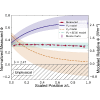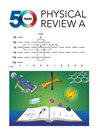Probing the position-dependent optical energy fluence rate in three-dimensional scattering samples
IF 2.9
2区 物理与天体物理
Q2 Physics and Astronomy
引用次数: 0
Abstract
The accurate determination of the position-dependent energy fluence rate of scattered light (which is proportional to the energy density) is crucial to the understanding of transport in anisotropically scattering and absorbing samples, such as biological tissue, seawater, atmospheric turbulent layers, and light-emitting diodes. While Monte Carlo simulations are precise, their long computation time is not desirable. Common analytical approximations to the radiative transfer equation (RTE) fail to predict light transport and could even give unphysical results. Therefore, we experimentally probe the position-dependent energy fluence rate of light inside scattering samples where the widely used and approximations to the RTE fail. The samples are three-dimensional (3D) aqueous suspensions of anisotropically scattering and both absorbing and nonabsorbing spherical scatterers, namely, microspheres () with and without absorbing dye. To probe the energy fluence rate, we detect the emission of quantum-dot reporter particles that are excited by the incident light and that are contained in a thin capillary. By scanning the capillary through the sample, we access the position dependence. We present a comprehensive discussion of experimental limitations and of both random and systematic errors. Our observations agree well with the Monte Carlo simulations and the approximation of the RTE with a correction for forward scattering. In contrast, the and the approximations deviate increasingly from our observations, ultimately even predicting unphysical negative energies.

探测三维散射样品中与位置相关的光能通量率
准确测定散射光随位置变化的能量通量率(与能量密度成正比),对于理解各向异性散射和吸收样品(如生物组织、海水、大气湍流层和发光二极管)中的传输至关重要。蒙特卡罗模拟虽然精确,但计算时间长,并不可取。辐射传递方程(RTE)的常见分析近似值无法预测光传输,甚至可能给出非物理结果。因此,我们通过实验探究了散射样品内光的位置依赖性能量通量率,在这些样品中,广泛使用的 P1 和 P3 近似 RTE 均失效。样品是由各向异性散射和吸收与非吸收球形散射体组成的三维(3D)水悬浮液,即含有和不含吸收染料的微球(r=0.5µm)。为了探测能量通量率,我们检测了被入射光激发并包含在细毛细管中的量子点报告粒子的发射。通过扫描穿过样品的毛细管,我们获得了位置依赖性。我们对实验限制以及随机误差和系统误差进行了全面讨论。我们的观测结果与蒙特卡罗模拟和修正了前向散射的 P3 近似 RTE 非常吻合。相比之下,P1 和 P3 近似值与我们的观测结果偏差越来越大,最终甚至预测出了非物理的负能量。
本文章由计算机程序翻译,如有差异,请以英文原文为准。
求助全文
约1分钟内获得全文
求助全文
来源期刊

Physical Review A
物理-光学
CiteScore
5.40
自引率
24.10%
发文量
0
审稿时长
2.2 months
期刊介绍:
Physical Review A (PRA) publishes important developments in the rapidly evolving areas of atomic, molecular, and optical (AMO) physics, quantum information, and related fundamental concepts.
PRA covers atomic, molecular, and optical physics, foundations of quantum mechanics, and quantum information, including:
-Fundamental concepts
-Quantum information
-Atomic and molecular structure and dynamics; high-precision measurement
-Atomic and molecular collisions and interactions
-Atomic and molecular processes in external fields, including interactions with strong fields and short pulses
-Matter waves and collective properties of cold atoms and molecules
-Quantum optics, physics of lasers, nonlinear optics, and classical optics
 求助内容:
求助内容: 应助结果提醒方式:
应助结果提醒方式:


